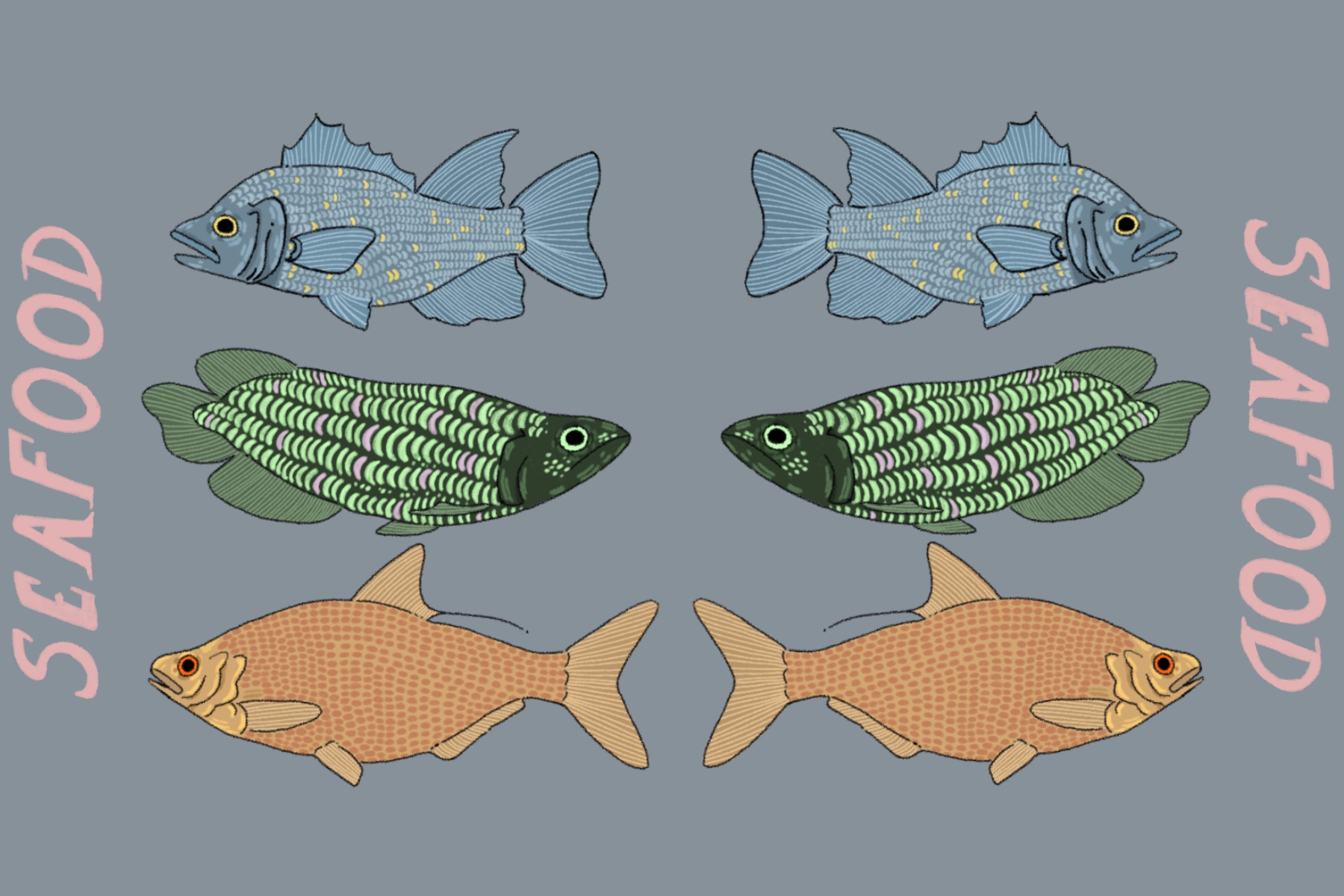Floridians have the geographical privilege of ready access to beaches, regardless of specific state locale. As a result, seafood and the attitudes surrounding it represent overarching cultural ideologies within the state’s populace.
In north Florida, namely the Panhandle and areas that are culturally part of the American South, seafood takes on traditional values of local sourcing and simple preparation.
In Miami, with its more diverse population, seafood comes to reflect the cuisines of its residents while being incorporated into fusion and high-end food.
These two starkly different ways in which seafood gets treated result in the persistent association of Southern seafood with poverty and Miami seafood with wealth.
The Florida Panhandle: Seafood as a Signifier of Poverty
In the Panhandle, the northwestern region of Florida that borders Georgia and Alabama, seafood restaurants typically serve fish straight from the water, with little to no time between ocean and plate. Southerners place great importance on serving what is nearby; seafood restaurants source their ingredients locally, from the Gulf of Mexico or from farms in the region.
The Seineyard Rock Landing in Panacea provides an apt look into what the best Southern seafood restaurants offer their patrons. Due to the ingredients sourcing and the style of preparation of Southern food, however, this well-developed cuisine has come to be associated with poverty, at least to outside observers. Southerners have perfected their unique way of serving seafood; the fact that it has been reduced to a low-class food in the minds of non-Southerners places stigma on an exceptional cuisine.
Traditional Southern seafood is simple in its excellence, down to the most basic of appetizers. Raw oysters are popular to start with, served with cocktail sauce and Saltine crackers. 90% of Florida’s oysters come from Apalachicola Bay, so restaurants in the Panhandle usually serve fresh oysters harvested that day.
Smoked fish dip frequents the menus of Southern restaurants as well; their complexity of flavor effectively opens any seafood-centric meal. The brininess of the whitefish, the warmth of the smoke, the brightness of the lemon juice, the creaminess of the binding agent: they work together to create a dish complemented perfectly by a simple cracker for a satisfying meal.
The main course typically revolves around whitefish that has been blackened, grilled or fried. Lightly fried fish is the staple, without a doubt, being the most popular choice for diners and a cornerstone of Southern cuisine. Grouper, snapper, flounder and mullet are the most ubiquitous options on the menu, plentiful in the area due to their numbers in the nearby Gulf of Mexico.
Fried fish in any Southern restaurant boasts an unmatched flakiness and warmth with its cornmeal breading, the perfect centerpiece for a good meal. Because seafood includes not only fish, other marine life such as shrimp, crab and scallops have their own signature plates that augment the complexities of Southern dining.
Shrimp is served either as a shrimp cocktail or Creole-style, drawing inspiration from Louisiana. Creole-style shrimp originated in New Orleans and features a tomato-based sauce and the classic Louisiana spice mix of chili powder, paprika, thyme, and oregano. Boiled crab legs in a basket with butter sauce are unmatched and pan-seared scallops provide a delicate sweetness.
The entrées around which Southern seafood culture revolves are undeniably culinary classics.
The sides in Southern cuisine supplement the subtle flavors of the seafood with their differences in texture and taste. Hushpuppies are made with the leftover breading from frying fish, essentially combining the excess cornmeal and flour with wet ingredients, to pop dollops of the mixture in a deep fryer. This results in a dense, brown lump that may not look gorgeous, but certainly tastes it. When eaten straight from the fryer, the golden-brown exterior has a mildly crispiness while the interior retains some aeration and moisture.
No comprehensive list of Southern dishes can neglect coleslaw, with its crunchy shredded cabbage, creamy mayonnaise and lemon juice for a punch. Coleslaw is the texture antonym to all things fried, cutting through the heaviness of its fried accompaniment and supplementing some ruffage into an otherwise vegetable-free meal.
A common theme throughout a deep dive into Southern cuisine is the locality of ingredients and use of inexpensive products. Many people consider mullet, which appears on nearly every seafood menu in the region, to be a bait fish. Fishermen use mullet to catch the more desirable trophy fish like tarpon and cobia, derisively dubbing it the “rat of the sea.” Mullet can be bought at lower prices than most other types of fish, leading to an association with poverty.
Additionally, the prevalence of cornmeal in Southern dining is remarkable. Its presence in fried food, hushpuppies, grits and cornbread can be attributed to its ready availability and affordability, which only encourages people to correlate the Southern diet with poorness. The Panhandle’s proximity to the boatyards where fishing really takes place ties seafood to bare feet and long days in the sun.
The rather unglamorous connection prevents Southern seafood from taking on a classy status within American society; it remains relegated to the ranks of uncultured cuisine.
Miami: Seafood as a Signifier of Wealth
Despite their geographical closeness, Miami and northern Florida could not be more different in their attitudes towards seafood. Where the Panhandle uses almost exclusively local ingredients, Miami’s nature as a cultural melting pot does not conduct that practice. In order to serve food from global cultures, restaurants must import certain non-local ingredients such as salmon and tilapia to accurately represent extra-continental cuisines. Seafood finds its basis less in local tradition and more in a welcoming of other cultures’ food.
Sushi restaurants are quite common in downtown Miami and Miami Beach, as the city boasts the presence of both Nobu and Uchi.
Nobu is known for its black cod with miso and new style sashimi, a minimalist salmon and sesame seed dish whose elegance highlights the flavor of the fish. The cod (estimated 5 ounces of fish) costs $52, and the sashimi (estimated 3 ounces of fish) $34.
According to the Uchi website, the akami crudo appetizer frequently receives compliments, and it consists of “bigeye tuna, aji amarillo, blood orange, pumpkin seed granola,” at a more reasonable but still substantial $22.50.
With its need for non-local, high-end fresh fish, sushi restaurants in Miami establish the standard that seafood signifies wealth and excess.
Peruvian ceviche can be found on many menus in Miami, and there are even a few restaurants dedicated solely to ceviche itself. Typically, ceviche is made with raw semi-firm whitefish that has been marinated in a lime juice, spices and herbs. This marinade, called leche de tigre (tiger’s milk), uses the citric acid of the lime juice to “cook” the fish in a similar way to heat. The result is an exquisite semi-cooked fish dish with a tart and spicy sauce frequently served with sweet potato or yellow corn. Purple onions and hot peppers impart their own unique kick on the dish, a true culinary marvel.
Despite the lime juice’s effects on the fish, ceviche still requires sashimi-grade fish in order to be safely edible, so run-of-the-mill fresh fish from the market does not meet the standard. Ceviche faces elevated prices due to the necessary grade of its seafood, and thus does not quality as a budget-friendly option.
In the most elite of restaurants in Miami, caviar readily appears. Typically accompanied by a crème fraîche or sour cream and a starch, caviar brings a potent briny flavor that engages the taste buds in a spectacular way. The eggs pop on the tongue as the cream and starch counterbalance the strong flavor.
With Tablé serving its appetizer “caviar and chips” for $98 and Gianni’s its Osetra caviar for $250, the eggs are far from accessible to everybody. Its market price ranges widely, but at the bottom end of the price range is the caviar that sells for $50/ounce.
To put this into perspective, the Southern Seafood Market in Tallahassee sells their premium yellowtail snapper for 62 cents per ounce.
Closing Thoughts
Miami and Tallahassee are less than 500 miles apart, and yet the culinary differences are staggering between their two regions of Florida. Miami has its eye-catching, avant garde dishes that cross cultural bridges, at the cost of, well, cost. Contrarily, the Panhandle forgoes flashiness for authentic, classic flavors sourced locally. The two styles of cuisine should be treated with equal respect, and yet only the Miami excess is afforded dignity, while Southern seafood regarded critically.
With an open mind it stays important to taste both styles of dining with the same consideration and acknowledge the merits to both.
















